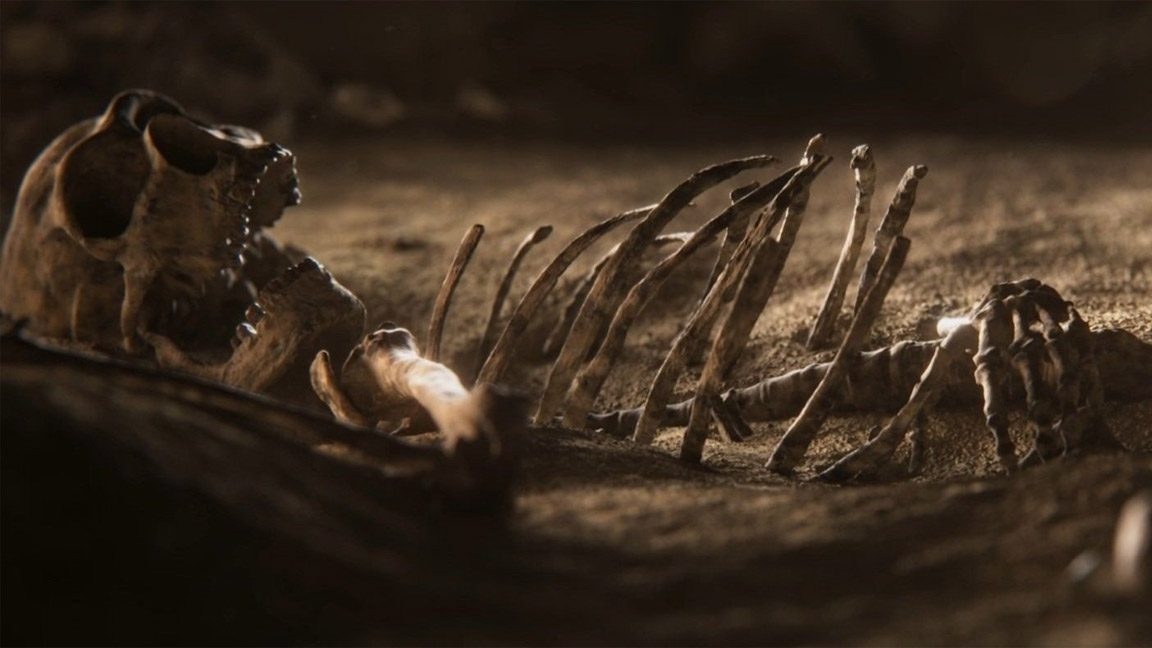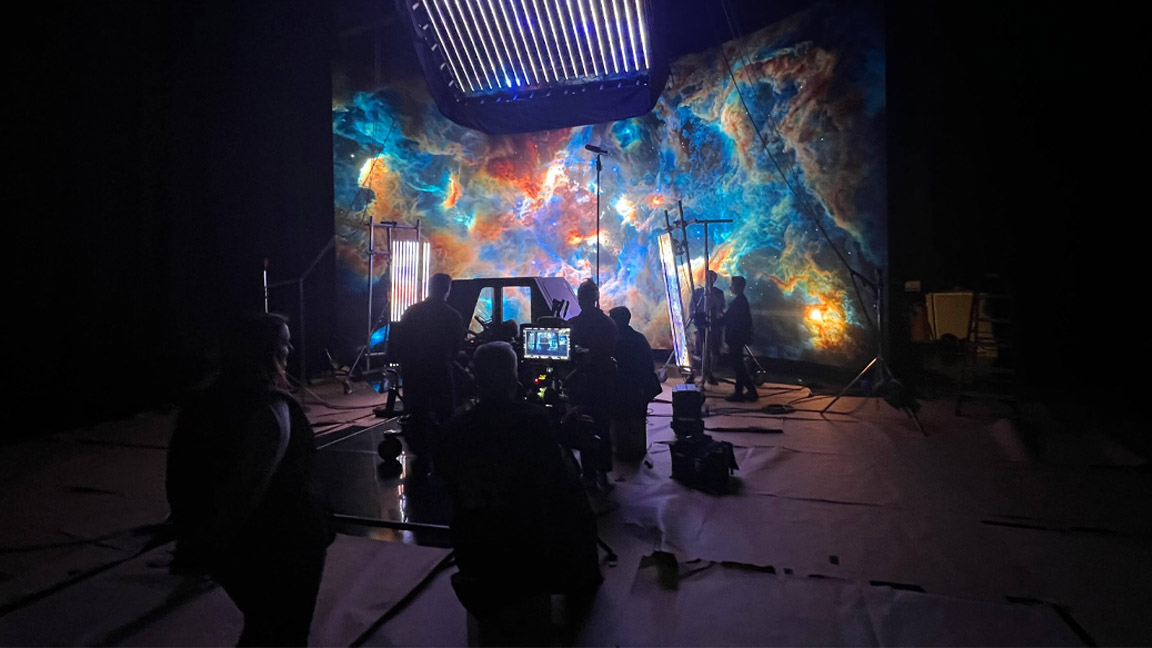
Good VFX is about storytelling; it's about revealing worlds, moments and emotions that don't exist, can't exist or have existed in emotional, detailed ways. One of the best studios capable of launching us into secret worlds and moments in history is the UK's Lux Aeterna.
The ambitious team has a track record of bringing history to life, whether that's the granular moments in the Secrets of the Neanderthals or taking us back to the dawn of time and the birth of the universe, this studio draws out the story in the sequences they've been tasked with crafting.
As I enter the studio an excitable little dog greets me, followed by a handshake from CEO and Creative Director Rob Hifle, who smiles warmly and takes me on a tour of the Bristol studio, eagerly sharing the team's work, including successful shows for Netflix and the BBC, that span docudramas such as Einstein and the Bomb as well as complex procedural volumetrics and cinematic lighting work on on season six of The Crown.
Rob's eyes light up as he explains using the their trademark cosmological VFX on The Crown's shots, as Prince William imagines drifting into orbit, and new work on Secrets of the Neanderthals that has involved recreating the Shanidar cave in northern Iraq using a complex puzzle of LiDAR data and new scientific papers, it's clear every new project for Lux Aeterna is a deep dive into learning new ideas and techniques but one this remains constant: "Fundamentally," says Rob reflectively, "everything we do is actually about telling stories".
The secret to VFX success

This is the nub. How does a growing team in Bristol, UK deliver large, complex shots that compete with London and Hollywood? This is grand-scale, impressive work - Netflix and BBC's Our Universe contains more than 700 high-end VFX shots created by the Lux Aeterna team over 18 months.
It comes down to passion, hard work and some new tools behind the scenes. VFX director Paul Silcox explains how the team has adopted USD - Universal Scene Description - as a major part of their pipeline to boost workflow, speed and delivery of shots. (Read about USD in our latest reviews of Maya and USD in 3ds Max for examples of how leading apps are integrating it.)
Paul tells me how rendering using USD has been a boon to the team, enabling the studio to deliver two big shows simultaneously without holding back the delivery. The VFX director explains how USD's XPU rendering, which means it uses both CPU and GPU, particularly for Houdini and Solaris, has really helped the studio.
Daily design news, reviews, how-tos and more, as picked by the editors.
He says, reflecting on the two ongoing deadlines: "We were able to render an entire show without the rendering affecting another ongoing delivery."
Paul tells me the team were able to "carve off a few machines" utilising the speed of XPU rendering at speed. He tells me another advantage of USD is the studio is able to leverage new technologies, as well as USD and CPU rendering, volume rendering using new AI denoising technology.


The spectre of AI appears, but here it's being leveraged to huge advantage. "We developed a process where, if you are going to render really heavy volumetric scenes like cloudscapes and you want to make them look really photorealistic, you have a lot of internal bounces resulting in heavy computation requirements. We stopped trying to attain a noise free render because we were able to use AI denoising on the individual AOV layers."
He adds, smiling and reflects on the Intel AI denoising process: "That was a treat. So we were able to take 16 hour renders down to four hours […] And then like I said, it was a brilliant test of Karma and our USD pipeline."
What this means for the Lux Aeterna team, explains Paul is, "the artist can now be allowed to essentially create more beautiful renders because they're rendering in shorter times. That single technology increases the quality of what we can offer and means we turn around shots quicker".
Technology that puts creativity first

Lux Aeterna's adoption of AWS Deadline Cloud, which enables teams to build a cloud-based render farm, has also helped workflow and enable greater complexity and freedom for the art team. Lux Aeterna has been working with the technology for three years and has integrated Deadline Cloud into the VFX pipeline.
"We've actually spent a lot of time with the development team at AWS to iron out issues and to test new tools," reveals Paul. "We're working very closely on their latest software and we have been key partners with them in developing Deadline and testing it over the last two years. And we're now in a position where we can, in certain circumstances, birth another thousand render nodes onto our render farm, which changes the game for us because it means that we can say 'yes' to short turnaround jobs or to high volume jobs or render things concurrently."
The focus on improving production flow, quality and speed is not simply about hitting deadlines. Paul explains how everything they do on the production side is geared towards improving the time and experience of artists. Because no matter how much you improve delivery times, "you have artists who will just take every available resource and try and do something with it and you don't want to get in the way really, to some degree," laughs Paul.
He adds: "If you can reduce the amount of stress that comes with some of these more technical renders, and with these heavy renders, that get pushed towards the end of the job, then you are more likely to deliver higher quality work. You're spending more time finessing your lovely shots than you are dealing with what happens at the end of the job."

As a company Lux Aeterna is trying to be as clever as possible with its resources and make use of the newest techniques, from AWS to USD and AI denoising, to "make everyone's life easier than across the board," says Paul. New technology, like specific types of AI and machine learning can help VFX studios really empower their artists to do more and reduce repetitive tasks. "They will enable us to perform better if we apply them in the right way," reflects Paul.
For a team like Lux Aeterna the new emerging technologies can enable them to take on bigger jobs and be ambitious. "For us," says Paul, "it's a two-way thing: it enables us to take on much bigger jobs, but it also enables us to be more creative as we can spend less time on the technical."
It's exciting to see how new technology, like certain types of AI, is being used on the coal face to improve efficiency, aid artists' creativity. Particularly when it comes to generating episodic content that has become more complex and demanding in recent years, and where quick turnaround requires an efficient pipeline.
Lux Aeturna now has what Paul calls "burst capability" for the episodic projects as well as the capability to commit to large, cinematic productions requiring 300 to 500 shots. It's not simply a question of render capability, but also of internal storage, pipeline management and creating an artist-focused environment, both internally and remotely, where creativity can grow. "You've got all of that in place then you are good to go […] And so these things that we use every day, they absolutely enable that opportunity. We always look at it like that opportunity is going to come along for us, so we need to be ready," remarks Paul.
AI will affect VFX creativity, but how?

Without doubt there are big changes coming to the VFX industry. Embracing USD is improving the pipeline for Lux Aeterna but also having a creative impact, enabling the team to go "software agnostic" in the future, so artists can pick and choose from more apps and renderers for each project that comes through the door to be greeted by a chirpy little dog.
"USD feels like it's going to open the door to a lot more collaboration," says Paul. AI and machine learning is also leading the industry down new roads, which the VFX supervisor reflects on, "I believe that it's really a catalyst for change and it is a brand new technology that we're all going to be using in one way or another."
As discussed, the team is already using AI denoising, but integrating machine learning workflows into a VFX business further feels unavoidable as the core software for VFX creation embraces AI tools. "I think we are going to see a lot of that over the next couple of years," says Paul.
Acknowledging the issues with AI scraping data from artists, Paul says the studio has been looking at various AI art tools for research, to understand them and how they will affect workflows. While saying generative AI tools that have scraped artists work isn't being, and won't be, used – "well that's not for us," states Paul – he confronts the issue: "You can see with the kind of work that we do, with all this amazing digital manipulation of imagery that AI is almost made for, you can see that our industry is going to be change a lot."

The AI debate is mute when a studio like Lux Aeterna can harness production tools like USD, AWS and new AI denoising tech to do more and free artists to be creative. "Our ambition is to take on more work and to grow," says Paul just as Rob Hilfe returns to the room, and agrees.
"We're able to compete on a global level," says the CEO, adding: "Putting all of these procedures in place means we can punch above our weight. Our intention has been to invest our pipeline, so we have the ability move fast, take on large scale productions and expand our on our VFX output."
Rob tells me the team is "hugely ambitious" but also explains how the focus is not merely on growth and doing bigger, more complex projects but also the future, and the use of AI tools, is about protecting creativity.
He says: "With these AI tools we're talking about giving the creative more time to be creative and that is huge for us and it keeps our creatives happy because the last thing you want to be doing is waiting for renders or wrangling files. If you can take that bottleneck away from the studio and give the artists the time to be artists, that is a huge benefit for us."
Paul adds: "It's all moving towards a point where the artist should just be able to do more interesting work, and they do, and it's about taking away the headaches." He suggests the VFX industry has shifted away from the horror of Midjourney's arrival, with its spaghetti fingered visuals, and after asking the question 'where does that leave a visual creative?' is gradually finding the answers.
"I feel personally that we're on the cusp of a really brilliant age of creativity," says Paul. "It's going to open up the door because it means that we can deal with less of the technical stress and focus on the creative."

The conversation comes full circle: storytelling. The team is experimenting with some AI tools for a non-commercial research project, a short film called Reno, as part of the My World initiative. AI filmmaking tools are increasingly being used, particularly by small teams, as we found out when we spoke with director Freddy Chávez Olmos, and Rob and Paul clearly see the Reno experiment as a way to build on what Lux Aeterna is capable of offering clients.
"We are storytellers," says Rob excitedly, and new AI tools and the improvements to the studio's pipeline is enabling this side of the team to flex, and find new creative outlets. "There's obviously the ambition to make that short into a longer film."
AI and machine learning, then, isn't just about the issues we hear about with regard to generative AI. At the business end of creating VFX some AI tools and new technologies are enabling smaller teams to think big, improve, grow and give artists room to be creative. The AI debate is a complex one, but Lux Aeterna is working hard to simplify the issues, finding a path through the controversy, finding new workflows that aid arists, and delivering impressive projects as a result.
Visit the Lux Aeterna website for more details on this Bristol-based VFX studio, examples of its work and contacts.

Ian Dean is Editor, Digital Arts & 3D at Creative Bloq, and the former editor of many leading magazines. These titles included ImagineFX, 3D World and video game titles Play and Official PlayStation Magazine. Ian launched Xbox magazine X360 and edited PlayStation World. For Creative Bloq, Ian combines his experiences to bring the latest news on digital art, VFX and video games and tech, and in his spare time he doodles in Procreate, ArtRage, and Rebelle while finding time to play Xbox and PS5.
